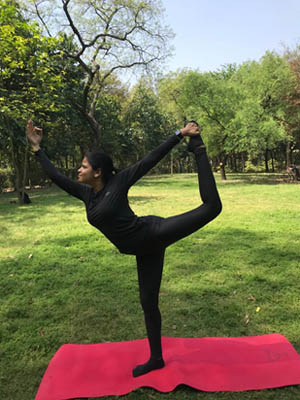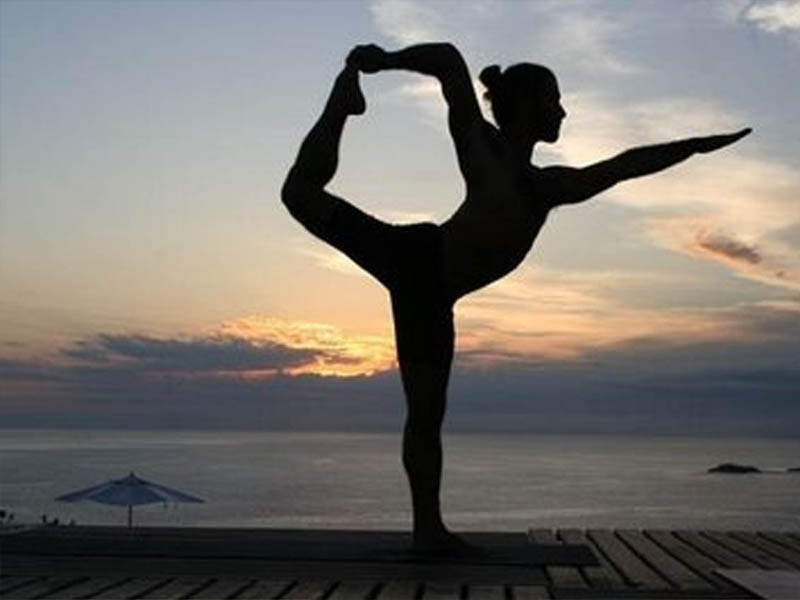Natarajasana or Lord of the Dance Pose is an asana. Sanskrit: नटराजासन; Nata- Dance, Raja- King, Asana – Pose; Pronounced As nut-ah-raj-AHS-anna. Nataraja is one of the many names of Lord Shiva. It is his dancing avatar, through which his love for music, dance, and art is depicted. If this asana is done properly, it resembles one of the dancing poses of Lord Shiva. Take a look at everything this asana has to offer.
In Hindu Mythology, Nataraja is a name given to Lord Shiva, for he used to perform a cosmic dance to rejuvenate his emotions, thus restoring balance in the universe.
Natarajasana is an advanced balance pose that brings grace, peace of mind and clarity. The pose is additionally a deep backbend that requires great strength in the entire front line of the body. The Front Line of the body extends from the quadriceps, through the hips, abdominals, chest and even the front of the throat.
What You Should Know Before You Do This Asana
This asana must be practiced on an empty stomach. You must make it a point to have your meals four to six hours before the practice so that the food is digested and the energy is ready to be expended. Also, make sure your bowels are empty before you practice.
How To Do Natarajasana
1. To begin with, stand in the Tadasana.
2. Breathe in, and lift your left foot, such that the heel is placed towards the left buttock and your knees are bent. Your entire body weight must be placed on your right foot.
3. Then, push the ball of the right thigh bone into the hip joint, and pull the kneecap up so that your standing leg is strong and straight.
4. Keep your torso upright. Grasp the left foot from the outside with the left hand. You must make sure your lower back is not compressed. So, make sure your pubis is lifted towards your navel. And as you do that, press your tailbone to the floor.

5. Begin to lift your left foot up, away from the floor and back, away from your torso. Extend the left thigh behind you and parallel to the floor. Your right arm must be stretched forward, such that it is parallel to the floor.
6. Hold this pose for about 15 to 30 seconds. Release,
7. bring back to your left hand to your hip
8. Release right foot and bring your leg down
9. come back to tadasana
10. breath freely and relax
11. And repeat on the other side as same procedure.
Precautions And Contraindications:
These are some points of caution you must keep in mind before you do this asana.
1. Avoid this asana at all costs if you have low blood pressure.
2. You could ask your instructor to help you gain balance when you begin practicing this asana. It is best that you consult a doctor before you do this asana
As a beginner, you might have a tendency to cramp the back of your thigh. You must ensure that the ankle of the raised foot is flexed. For this, you must move the top of your foot closer to the shin.To deepen the pose, you could catch the inner part of your left foot with your right hand swept behind your back. Grab the outer edge of your left foot with your right hand. This is a more challenging stance and will increase your ability to balance better. This variation will raise your chest and give a deeper stretch to your shoulders.
Benefits Of The Natarajasana
Physical Benefits
Stretches the chest, shoulders, quadriceps, front body, including the abdomen. Strengthens upper back, quadriceps, ankles and feet. The pose develops greater strength and flexibility in the body each and every time you practice it. Because there is no way to cheat yourself into Lord of the Dance, you must work continually within to achieve the highest expression of the pose.
Energetic Benefits
The pose represents Cosmic Energy, and when you practice you are dancing in the flow of the Universe. This pose can stimulate blood flow in the body, as well as raise your energy level, as you are working quite hard in the pose. There are constant internal adjustments happening in the body that help the yogi stay balanced and stable in this pose. This helps to exercise the small, stabilizing muscles that are difficult to strengthen. By opening up your body in this powerful way, you will also open up your mind to new possibilities. Yoga asanas are symbolic and meaningful, and can add great value to the yogi by bringing in fresh new perspectives. Lord of the Dance Pose is a very big heart opener that can heal heartbreak, and can help one discover their compassion for self and others too. This pose can help the yogi to see and accept all the tiny perceived “faults” of others, as well as their own. Natarajasana also improves your concentration and focus as you increase the length of time in the pose, you increase the intensity as well. Due to the intense focus required to practice this pose, it is excellent for those people who have a busy mind that will not shut off.
These are some other amazing benefits of Natarajasana pose.
- This asana increases your metabolism and helps in weight loss.
- It gives your groin, abdominal organs, and thighs a good stretch.
- Your posture is improved, and balance is increased.
- It helps better your digestion.
- You tend to focus more and are also relieved of stress. This asana calms your mind.
- Your body becomes flexible.
- Your hip flexors are opened up.
The Science Behind The Natarajasana
This asana is a beautiful combination of structure and movement, and it symbolizes the dance of the graceful Nataraja. It helps to make you strong, and opens up your mind and body, giving them so much grace and power. It is a deep backbend. As you bend and your body balances on one leg, you are constantly challenged. When you overcome the challenge, you attain a sense of peace and calm. This asana opens up the heart. It asks of us to be stable but at ease, dedicated, yet non-attached, engaged, yet at peace. When we are open to and accept both movement and structure, this asana helps draw a clear communication between our being and the teacher in the heart.
 |
Dr. Sujata Panda, PhD in Yoga, DNYS, N.D., Gold medallist, Founder of Su-Ham Foundation Owner of Viroga Virtual Clinic |


